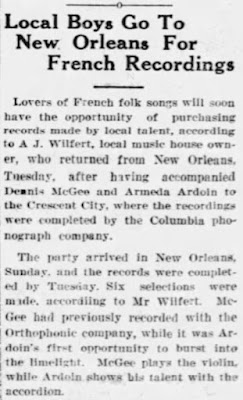 |
| Eunice News Dec 13, 1929 |
Born in 1898, Ardoin lost his father in an accident when he was nine months old. His mother and seven brothers eked out a living as sharecroppers in Eunice in St. Landry Parish. As a teenager, Ardoin acquired an accordion and taught himself to play it. Illiterate, he also “wrote” songs that seemed to vary with every rendition.1 Poet Darrell Bourque states:
He never sang a song the same way twice. He’d change the lyrics. He made up the songs. It’s all in the oral tradition.1
He, chère catin, malheureuse,Tu connais moi j't'aime avec tout mon coeur, malheureuse,Tu devrais, mais, pas fair ce ça, mais, t'après faire, mais, malheureuse,C'est pour ça, chèr 'tit monde, tu fais du mal à mon coeur.Malheureuse, tu connais, chère 'tit fille, tu vas pleurer,Pour ça tou t'es après faire, tu m'as dit, chère 'tit fille, mais criminelle,Malheureuse, tu connais tu vas pleurer, mais, malheureuse.

This song is something the Cajuns call a 'valse à deux temps', or a 'two-step waltz', as it has two dotted quarter notes per measure for rhythm guitar.2 Sometimes referred to as a 'waltz in two beats', the pattern was made popular in France during the 1840s and involved the gentleman beginning with his left foot and the lady with her right, and together they'd take one step forward and then one step back.3 Joshua Caffery makes note of songs with this particular rhythm.
A 'valse à deux temps' originally referred to a dance step rather than a song type. Although the notion of a "two-step waltz" seems counterintuitive, as waltzes and two-steps are generally considered two discrete, even opposite, steps, particularly in Louisiana and Texas, the 'valse à deux temps' is simply another style of dancing to a triple meter.5
 |
| Amede Ardoin |
According to Dr. Barry Ancelet, it was a style already familiar to Cajuns before Americans had migrated into the area.
From their Anglo-American neighbors, [Cajuns] learned jigs, hoedowns, and Virginia reels to enrich their growing repertoire which already included polkas and contredanses, varsoviennes and valses à deux temps.4
Soon Ardoin was in great demand to play and sing—in a voice that has been described as haunting and unearthly—at house parties and little country honky-tonks. Ardoin reworked his "La Valse A Austin Ardoin" into this more well known song, "Taunt Aline". It would later become Iry Lejeune's 1954 recording "Viens me Chercher" and the Balfa's 1974 recording "J'Sus Orphelin".
Hey, dear little doll, oh my,
You know I love you with all my heart oh my,
You shouldn't, well, do what you're doing, well, on my,
That's why, dear little one, you hurt my heart.
Oh my, you know, dear little girl, you'll cry,
For what you're doing, you told me dear little girl, well, it's criminal,
Oh my, you know you'll cry, well, oh my.
- http://www.countryroadsmagazine.com/culture/history/bringing-amede-back-home
- Ye Yaille Chere by Raymond Francois
- https://en.wikipedia.org/wiki/Valse_%C3%A0_deux_temps
- Cajun and Creole Music Makers By Barry Jean Ancelet
- Traditional Music in Coastal Louisiana: The 1934 Lomax Recordings By Joshua Clegg Caffery
- http://theind.com/article-16337-l'effet-papillon.html
- Hidden in the Mix: The African American Presence in Country Music edited by Diane Pecknold
- Photo by Jeremy S
W111384-2 Taunt Aline Columbia 40514-F, OKeh 90014
W111385-2 Two Step De Mama Columbia 40514-F, OKeh 90014
Find:
Amadé Ardoin – Louisiana Cajun Music Vol. 6 : Amadé Ardoin – The First Black Zydeco Recording Artist (1928–1938) (Old Timey)
Cajun Early Recordings (JSP, 2004)
Prends Donc Courage - Early Black & White Cajun (Swamp Music Vol. VI) (Trikont, 2005)
Cajun Dance Party: Fais Do-Do (Legacy/Columbia, 1994)
The Best Of Cajun & Zydeco (Not Now, 2010)
Mama, I'll Be Long Gone : The Complete Recordings of Amede Ardoin, 1929-1934 (Tompkins Square, 2011)

No comments:
Post a Comment
Got info? Pics? Feel free to submit.